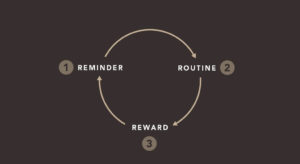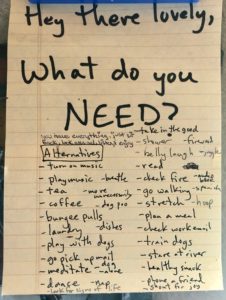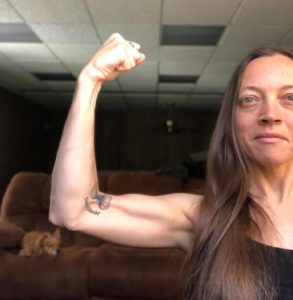[s2If current_user_cannot(access_s2member_ccap_course_004_hh)]
To view this lesson, please purchase this course or log in if you have already purchased it.[/s2If][s2If current_user_can(access_s2member_ccap_course_004_hh)]
I’m starting this course off with a discussion of habits, because changing one’s habits is incredibly empowering. And it can be easier than most people think.
Besides, I also want you to get the benefit of working through the entire course, and that requires creating a new habit of getting online and engaging with the material.
Habits can get kind of a bad name, like addictions, but habits are actually just behavior that’s repeated so often that we don’t even need to think any more.
Literally, habits can bypass thought. That’s simultaneously really awesome and really terrifying.
 Habits are amazingly efficient. As long as that habit helps us survive AND thrive, thats great.
Habits are amazingly efficient. As long as that habit helps us survive AND thrive, thats great.
For example, it’s useful to drive a car and be able to press the brakes or steer without thinking. Not so for habits that damage the body, relationships, mind, etc.
In his book, “The Power of Habit: What We Do in Life and Business,” neuroscientist Charles Duhigg explains how brain activity is different when a habit is triggered.
If we don’t have a habit, brain activity is pretty active the whole time while we (or our dogs) do the behavior. If we do have a habit, then there’s a little spike right as the habit is activated, and then the brain waves fall off: autopilot.
In fact, whenever we perceive a cue to do a habit, our brain activity spikes with craving, because we are already anticipating the reinforcer. The key to changing habits with people is the same as it is with dogs: create a way for a new behavior to get the same reinforcer, to meet the same craving, or better yet, the need underneath it.
Change the environment enough that one remembers to do the new behavior and still get that same need or craving met, and voila!, the habit is changed.
No shaming, blaming, self control, any of that. It’s just like dog training, only with people. Just set up your environment to meet your needs/cravings in healthy ways.
By “healthy” habit, I mean habits that don’t interfere with meeting your other needs for thriving.
Changing a habit really is that simple: replace your old habit with a healthy one that meets the same need or craving.
- What’s the function of the current habit (behavior) or what craving does it satisfy?
- Which healthy habit could achieve the same thing?
- Find all environmental cues that trigger the current habit, and change things so you’ll get a reminder to do the new habit, instead.
“Simple is not easy,” as the saying goes. The hard part is finding all of the triggers for the habit and getting them to direct to the new habit. But once you have that, it’s usually pretty easy.
In Karen Pryor’s wonderful “Don’t Shoot the Dog” book, she writes:
Training an incompatible behavior is quite useful in modifying your own behavior, especially when dealing with emotional states such as grief, anxiety, and loneliness. Some behaviors are totally incompatible with self-pity: dancing, choral singing, or any highly kinetic motor activity, even running. You cannot engage in them and wallow in misery simultaneously. Feeling awful? Try Method 5.
But building a life that you love isn’t just about replacing old habits with random ones. It also can be useful to look at which needs are not being met, what values or spirit you want to have and create habits to get there.
That’s just like dog training, too. Only it’s not a dog, it’s your own mind!
I read the “Power of Habits” book and made some drastic and immediate changes to my own habits. They were all actually pretty easy, which was stunning to me:
- I lost 35 pounds in 2 months, without feeling hungry or dieting. That weight never came back.
- I became more consistent about being vegan
- I began meditating regularly again
- I trained my dogs regularly again
- I started regularly hiking in the woods behind my house
- I stopped eating processed sugar again (not zero, but practically none)
- I stopped drinking alcohol and coffee (not zero, but practically none)
Yes, all at once. That worked for me, might be too much for you. I was simply ready for all of those changes, just needed structure to make it happen.
Let’s look at my weight loss:
I was clearly eating more than my body needed, so I knew there must have been a function for that extra eating. Looking more closely, there were two problems. First, I was eating at times when I wasn’t hungry (snacking). Second, when I was eating a meal, I would also continue eating when I was actually no longer hungry. In both cases, I was eating when not hungry. I determined that eating was just an activity to do.
That led to one specific new habit: asking myself if I was hungry before I put food into my mouth. This is actually just an instance of a general new habit: interrupting the habit process, or as Viktor Frankl wrote, “inserting a pause between stimulus and response.” Mindfulness is extremely useful.
Because of this eating habit change, and the regular meditation, I started being more mindful of everything I did. Before lots of activities, I began asking myself: “Which need will this behavior meet? Is it the healthiest way to meet that need?”
Again, by “healthy,” I mean it facilitates (or at least doesn’t get in the way of) meeting my other needs. It’s not just good for this one need, but it helps Future Grisha meet other needs.
So I had the sequence:
Stand at refrigerator –> Eat –> boredom relieved
I had to insert a pause between stimulus (sight of refrigerator) and response (eating). I could have done it sooner in the sequence, like when I first had the desire to eat, and that did happen eventually, but the refrigerator is magnetic, so it’s a great place to put signs with new cues.
I put up two notes. One read: “Are you hungry? If you feel hungry, drink water, and if you are still hungry, come back.”
The second note read: “Look for signs of life,” which was my way of telling myself to go to the window and look out to enjoy the movement of nature.

Next to the window, I had another note, which read:
“Hey there, lovely, what do you NEED?”
And I listed about 20 boredom busters, including “make a cup of tea,” “walk the dogs,” “dance,” “phone a friend,” “meditate,” “rest in the hammock,” and “I need nothing right now. Feel the itch to alleviate boredom and let yourself relax.”
So now my new sequence was essentially:
Stand at fridge –> recognize that I’ve hit an eating trigger –> ask what I actually need/crave at that time –> do a healthy behavior –> need met
Or more simply:
habit is triggered –> notice I’ve been triggered –> bring awareness to current needs –> healthy behavior –> need met
Once I had changed that habit, it became simpler and simpler to interrupt any habit sequence. I wasn’t just changing my eating. I was actually taking a quick inventory of my current needs.
Compare that to what would happen if I were to use shame to change behavior. I’d recognize a habit trigger, but then pile on shame to try to stop the pull I’d feel toward the craving. That habit would just punish the behavior of noticing the triggering (not helpful). It also wouldn’t meet the need or satisfy the craving, and I’d likely do the habit anyway, with more shame for not having self-control. Shame is basically a set-up for failure, for more shame.
I don’t shame or mock other people, I don’t heap punishment on my dogs. Why would I do that to myself? My inner child needs to know that she is ALWAYS safe with me.
I find it much more helpful to create a habit of trigger awareness as the cue for awareness of needs:
trigger –> “yay! I found a trigger!” (mini reward) –> “What does that mean I need?” –> healthy behavior –> needs met
Instead of worrying about having so many triggers for my problem habits, I can celebrate that I have so many reminders to check in with my, to build authenticity. “What do I need right now?”
Between stimulus and response there is a space. In that space is our power to choose our response. In our response lies our growth and our freedom. -Viktor E. Frankl
In terms of alcohol and caffeine, awareness inserted after a trigger became so useful. Society wouldn’t have considered me an alcoholic or caffeine junky, but my new awareness made me realize that these were things I consumed when I wanted to override my physical or emotional needs in order to meet obligations. I drank coffee when I thought I “should” be awake, but my body was not up for it. I drank alcohol when I thought I “should” be in a social situation that my spirit wasn’t enjoying, when I really looked at it.
There are so many little trick products like this, that meet a craving, but block the need.
By taking those items off of my personal menu, I began being much more authentic. I could hear my inner child and the needs of my protein suit (my body). I was resting when I needed rest. When my mind and heart needed quiet time, I said no to social invitations and got quiet time. When I engaged in social activities, my yes was an authentic yes, and that led to deeper, more wonderful friendships.
Habits are an efficient use of memory. They can be a way to trick my instant-gratification system into being quiet, because I don’t stop to think of my short-term cravings. In order to build a habit, it helps to build in some instant gratification (well-timed reinforcement), even if it’s unrelated.

For example, one month before my husband died this year, he inspired me to start doing pushups. As little grief ritual, I usually do 30 standard push-ups in the morning before brushing my teeth.
That way, my pushups get a little bit of reinforcement from the toothbrushing, which itself is reinforced by the mint of the toothpaste. I also try to really notice the boost of energy in my system that comes from even a super-brief workout.
The pushup habit happens before I can even really think about it. In the long term, I’m enjoying a more stable core and sexier, stronger arms, but in the short term, doing the well-established habit of toothbrushing reinforces the push-ups. That’s the Premack Principle at work.
The Premack Principle is a principle of behavior that we dog trainers love to take advantage of: access to a more likely behavior will reinforce a less likely behavior. Or in other words: strong habits reinforce weak habits.
So if I “get” to brush my teeth after pushups, then the new pushup habit is reinforced.
Here’s a good summary of The Power of Habits, by Charles Duhigg. Note: the summary is NOT written by the author and one thing this person includes that the author doesn’t is some fat-shaming (thanks for pointing that out, Christine!).
The book author (Duhigg) makes a good point of noting that cultivating shame doesn’t help with habits, that it’s just behavior and we have the power to change it. So please ignore the quick bit in this video that could be considered fat shaming — it’s not in the spirit of the book. Feel free to discuss it in the course group.
Ironically, the first time I got the book, it also took me a really long time to open it up and read it. It’s like I didn’t actually want my habits to change. Then when I did, I read it and immediately crafted my habits to more closely match my spirit and values.
Habit hacks:
- Calendars make good reinforcers! Print a calendar and completely color in the date square for every day that you do your new habit. Research says fully coloring in the is square more effective for habit change than just X’ing out the day. You can print multiple calendar pages (one for each habit). Then you can look back at the calendar and see progress.
- You can use the data from the calendar to reinforce long-term goals. For example, you could have a goal of engaging with the How to Human course at least 50% of the days for the next 6 weeks. If you achieve that, you could give yourself a no-chores day or something special that you’ve been wanting to buy.
- Telling friends that you intend to change your habit helps! It gives you some social accountability. Only tell people who support your habit change.
- Shame doesn’t help with habit change. If you slip up, treat yourself like a dog you were training with positive reinforcement: change the environmental conditions to make the new habit a more obvious choice and/or find a better reinforcer.
- For particularly persistent habits, where it’s hard to consistently cue the new behavior, hypnotherapy can be quite helpful. I know it sounds kind of out there, but it’s actually clinically quite effective. Hypnotherapy can essentially plant a new cue and strengthen the effect of the cue to do the new habit, and if your new habit meets the old need/craving, it gets automatically reinforced, and the new habit can take over. You can also do it yourself, but it’s handy to consult with a professional the first time. Check out some research here, here, and here.
[/s2If]